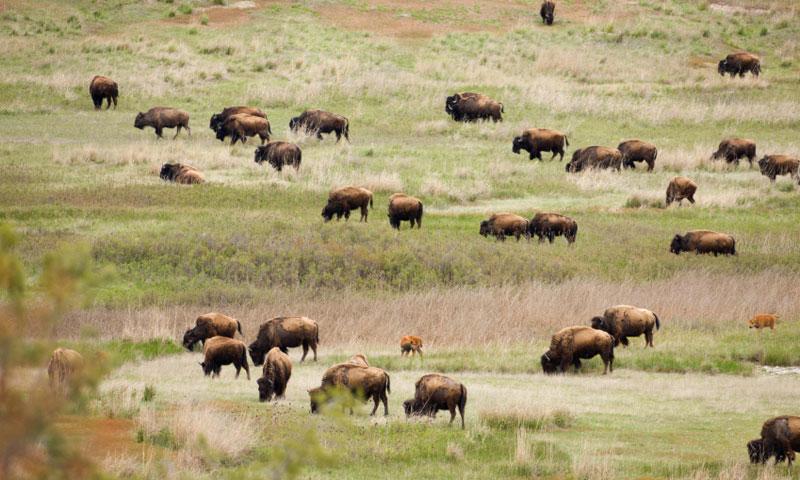The CSKT Bison Range: A Story of Restoration and Resilience
The Confederated Salish and Kootenai Tribes (CSKT) Bison Range is a testament to the tribes’ vision and commitment to wildlife conservation. Formerly known as the National Bison Range, this area has a rich history that intertwines with the survival of the American bison and the cultural heritage of the CSKT.
In 2020, Congress passed the Bison Range Restoration legislation, placing the Bison Range under the federal trust ownership of the CSKT. This historic move marked a significant chapter in the conservation story of the American bison and the CSKT’s stewardship of their ancestral lands.
The CSKT Bison Range
The CSKT Bison Range, situated in Montana’s Lake and Sanders counties, is a habitat/species management area spanning over 18,800 acres. Established in 1908, this nature reserve is home to a herd of 350 adult bison, with an annual addition of 50-60 calves.
Apart from offering a safe haven for bison, the range is also a significant ecosystem comprising grasslands, Douglas fir and ponderosa pine forests, riparian areas, and ponds. A host of other mammal species including elk, mule deer, bighorn sheep, and black bear, as well as numerous bird species, call this range home.
A Historical Perspective
The bison, once numbering in the tens of millions, were nearly extinct by the 1890s due to a federal government-sponsored eradication program. However, the bison’s story of survival is closely tied to the CSKT. Oral accounts recall a Pend d’Oreille tribesman named Atatice who led six orphan bison to the Flathead Reservation, laying the foundation for the future Pablo-Allard herd.
The Pablo-Allard herd grew to about 300 and roamed wild along the Flathead River. By the early 1900s, this herd was said to be the largest collection of bison remaining in the U.S.
Establishment of the National Bison Range
Recognizing the value of these majestic creatures, the U.S. Federal Government established the National Bison Range in 1908. Morton J. Elrod, founder of the Flathead Lake Biological Station, suggested the Flathead Reservation for this purpose. President Theodore Roosevelt authorized funds to purchase land specifically for wildlife preservation, marking a landmark moment in the history of wildlife conservation in the U.S.
The initial herd for the National Bison Range was purchased from the Conrad herd, supplemented by donations from Charles Goodnight of Texas and the Corbin herd in New Hampshire.

CSKT’s Role in Bison Conservation
The CSKT have a deep-rooted connection with the bison, considering them not only a vital food source but also a significant part of their spiritual beliefs. As such, the tribes have been instrumental in the conservation efforts for the American bison.
In 1994, the CSKT entered a government-to-government agreement with the U.S. Fish and Wildlife Service. This agreement allowed the tribes to participate in refuge programs of special geographical, historical, or cultural significance.
Restoration of the Bison Range
After more than a century of federal management and nearly two decades of negotiations, the Bison Range was finally restored to the Flathead Indian Reservation in 2022. This move signified a monumental shift in the management of the Bison Range, with the CSKT natural resource employees now overseeing its operation.
The tribe adopted the current Comprehensive Conservation Plan developed by the U.S. Fish & Wildlife Service for the interim management of the Bison Range.
Impact of the Restoration
The restoration of the Bison Range has had far-reaching implications. It signifies a victory for tribal sovereignty and a step towards rectifying historical wrongs. It also showcases the CSKT’s commitment to natural resource management and wildlife conservation.
The public can expect to see little change in the day-to-day operations of the Bison Range. The entrance fees have been increased, and the funds generated from these fees are used for the management and operation of the Bison Range.
The Future of the CSKT Bison Range
The CSKT Bison Range continues to be a beacon of wildlife conservation and a testament to the resilience of the American bison. With the CSKT now at the helm, new exhibits and accurate historical information are being introduced at the visitors’ center.
The Bison Range remains a popular destination for wildlife enthusiasts, offering two scenic roads for prime viewing of the bison and other wildlife. It will continue to serve as a vital ecosystem for numerous species and a symbol of the tribes’ enduring connection with the land and the bison.
The story of the CSKT Bison Range is one of resilience, restoration, and a deep-rooted respect for wildlife. It’s a tale that intertwines the survival of the American bison with the heritage of the CSKT. With the Bison Range now under the stewardship of the CSKT, it is poised to continue its legacy of wildlife conservation and serve as a testament to the tribes’ commitment to preserving their ancestral lands and the species that inhabit them.
